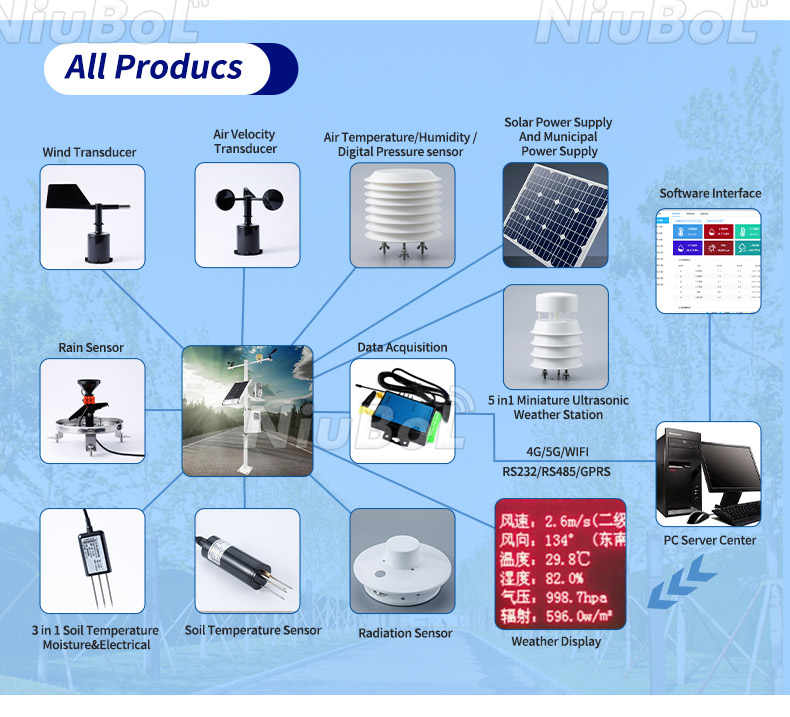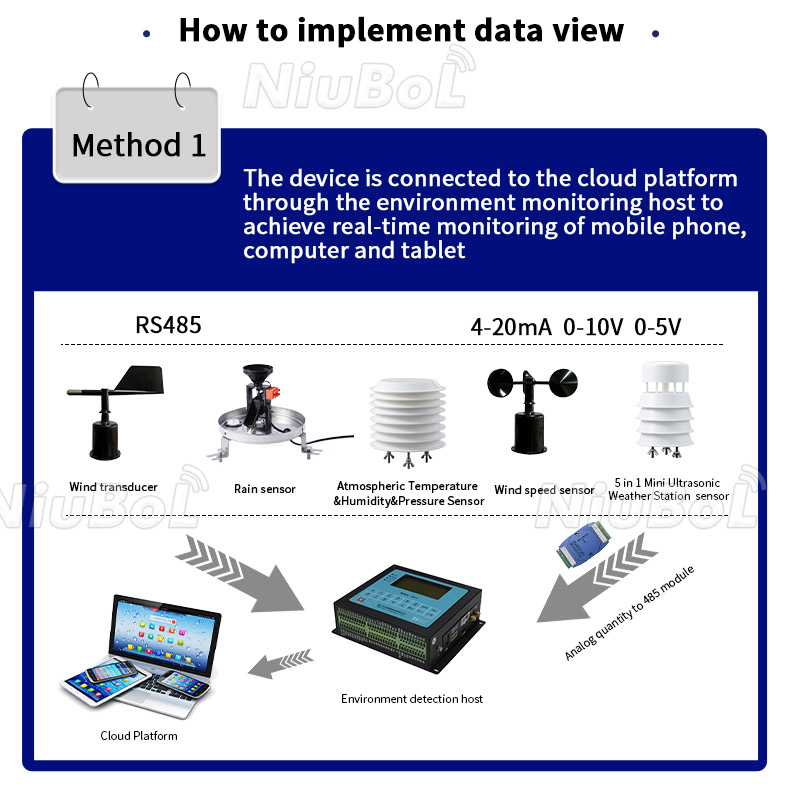

— Blogs —
—Products—
 Consumer hotline +8618073152920
Consumer hotline +8618073152920 WhatsApp:+8615367865107
Address:Room 102, District D, Houhu Industrial Park, Yuelu District, Changsha City, Hunan Province, China
Product knowledge
Time:2022-06-30 21:12:13 Popularity:595
The development of modern agricultural technology, including the integration of agricultural weather stations, plays a crucial role in ensuring optimal crop and livestock growth. These stations collect and analyze environmental data to make informed decisions, improve productivity, and safeguard resources. Below is a detailed overview of the main business and functions of agricultural weather stations.
Agricultural weather stations are used to monitor key environmental factors affecting the growth of plants and animals. These stations are critical for creating an optimized growing environment, providing real-time data on conditions such as temperature, humidity, wind speed and direction, rainfall, solar radiation, and more. The data collected helps farmers make informed decisions to manage irrigation, pest control, fertilization, and other essential farming activities.

- Air Temperature: Air temperature is one of the most important factors influencing crop growth. If temperatures are too high or too low, plants may not grow optimally or may even suffer damage.
- Humidity: Humidity affects both the growth of plants and the health of livestock. For example, high humidity can promote fungal diseases in crops, while low humidity may stress plants and animals. Monitoring humidity helps ensure that these conditions are within a range that supports healthy growth.
- Sensors Used: Air temperature and humidity sensors are integrated into agricultural weather stations. These sensors send real-time data to a central monitoring platform, allowing farmers to adjust their operations, such as heating, ventilation, or irrigation, to maintain ideal growing conditions.
- Alerts and Adjustments: If the temperature or humidity exceeds preset thresholds, the system can trigger alerts, allowing for quick manual or automated interventions, such as adjusting irrigation or controlling greenhouse environments.
- Soil Moisture Sensors: These sensors measure the moisture content in the soil, which directly impacts plant health. Insufficient moisture can lead to drought stress, while excessive moisture can cause root rot or poor oxygenation.
- Additional Soil Parameters: In addition to moisture, agricultural weather stations monitor other key soil conditions, such as:
- Soil Temperature: Influences seed germination, root development, and microbial activity.
- Soil Nutrients: Sensors can measure levels of essential nutrients like nitrogen, phosphorus, and potassium, ensuring the soil is conducive to crop growth.
- pH Levels: Soil pH affects nutrient availability and microbial activity, which influences plant health.
- Electrical Conductivity (EC): Measures the salinity of the soil, which is important for assessing irrigation needs.
- Data Analysis: The data gathered from soil sensors is analyzed to determine the moisture, nutrient, and temperature conditions, helping farmers adjust their irrigation schedules and fertilization practices.

- Impact on Crops: Wind speed and direction can have significant effects on agriculture. Strong winds can cause physical damage to crops, such as lodging (when plants are blown over), loss of flowers or fruits, and spread of diseases and pests.
- Pollination: On the other hand, moderate wind speeds can aid in the natural pollination process by spreading pollen, especially in crops like corn, wheat, and other wind-pollinated plants.
- Monitoring Parameters: Weather stations are equipped with anemometers to measure wind speed and wind direction. The data collected allows farmers to assess whether wind conditions are favorable for crop health or if protective measures, such as windbreaks, are needed.
- Wind Impact on Pest and Disease Control: Wind can also influence the movement of pests and diseases. Monitoring wind patterns can help predict and manage pest outbreaks, minimizing crop damage.
- Rain Gauge Sensors: Accurate rainfall measurements are vital for assessing water availability and planning irrigation needs. Too much rainfall can lead to waterlogging, while too little can cause drought stress.
- Irrigation Management: By monitoring rainfall, agricultural weather stations help farmers determine whether supplemental irrigation is needed and adjust water usage to conserve resources.
- Yield Prediction: Rainfall data, in conjunction with other environmental factors, helps forecast crop yields and plan harvest schedules.
- Importance for Photosynthesis: Solar radiation plays a critical role in photosynthesis, which is the process by which plants convert sunlight into energy for growth. Monitoring the amount of solar radiation provides insight into the effectiveness of light conditions for plant health.
- Weather Stations' Role: Agricultural weather stations can measure solar radiation using pyranometers. The data collected helps optimize greenhouse light management, shade control, and crop placement.
- Impact on Weather Patterns: Barometric pressure readings help forecast short-term weather changes, including storm systems. Sudden drops in pressure are often associated with approaching storms or heavy rain, which can affect crop and livestock conditions.
- Animal Health: Fluctuations in barometric pressure can also impact animal behavior and health. For instance, sudden drops in pressure may cause stress to certain livestock species, affecting their feeding and overall well-being.

- Data-Driven Decision Making: By providing real-time, accurate data on a wide range of environmental factors, agricultural weather stations enable farmers to make informed decisions that improve productivity and reduce waste.
- Optimizing Resource Use: Efficient irrigation, fertilization, and pest control can be achieved by using weather station data, minimizing resource consumption and promoting sustainability.
- Predicting and Mitigating Risks: Early warnings based on weather data, such as extreme temperatures, droughts, or storms, help farmers take preventive measures to protect crops and livestock.
- Improved Crop Yields: By maintaining optimal environmental conditions, weather stations contribute to healthier crops and higher yields, which translates to increased profitability.
- Cost Savings: Automation based on weather data can reduce the need for manual interventions and reduce operational costs in areas such as irrigation, heating, and ventilation.
Conclusion
Agricultural weather stations are indispensable tools for modern farming, as they monitor a wide range of environmental factors that affect plant and animal growth. By providing real-time data on air temperature, humidity, soil conditions, wind patterns, rainfall, and more, these stations enable farmers to optimize their agricultural practices, enhance productivity, conserve resources, and mitigate risks. With the increasing reliance on data-driven decision-making in agriculture, weather stations play a vital role in ensuring the sustainability and success of modern farming practices.
Related recommendations
Sensors & Weather Stations Catalog
Agriculture Sensors and Weather Stations Catalog-NiuBoL.pdf
Weather Stations Catalog-NiuBoL.pdf
Related products
 Combined air temperature and relative humidity sensor
Combined air temperature and relative humidity sensor Soil Moisture Temperature sensor for irrigation
Soil Moisture Temperature sensor for irrigation Soil pH sensor RS485 soil Testing instrument soil ph meter for agriculture
Soil pH sensor RS485 soil Testing instrument soil ph meter for agriculture Wind Speed sensor Output Modbus/RS485/Analog/0-5V/4-20mA
Wind Speed sensor Output Modbus/RS485/Analog/0-5V/4-20mA Tipping bucket rain gauge for weather monitoring auto rainfall sensor RS485/Outdoor/stainless steel
Tipping bucket rain gauge for weather monitoring auto rainfall sensor RS485/Outdoor/stainless steel Pyranometer Solar Radiation Sensor 4-20mA/RS485
Pyranometer Solar Radiation Sensor 4-20mA/RS485
Screenshot, WhatsApp to identify the QR code
WhatsApp number:+8615367865107
(Click on WhatsApp to copy and add friends)